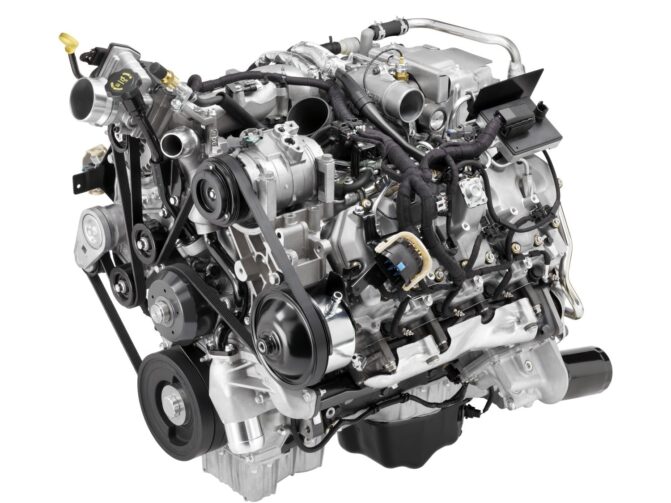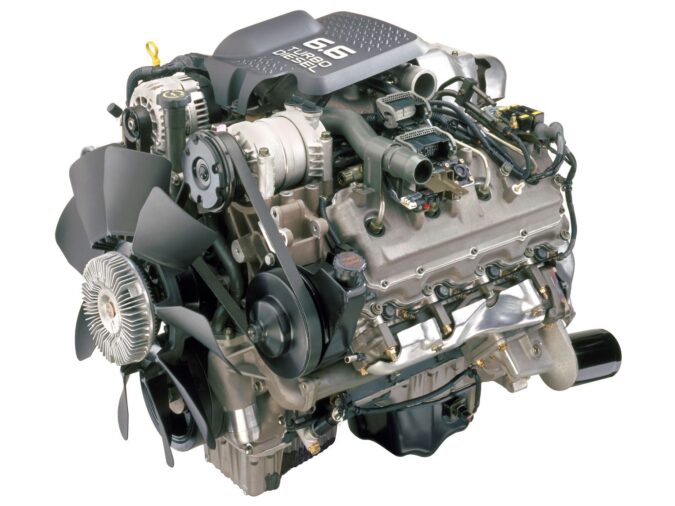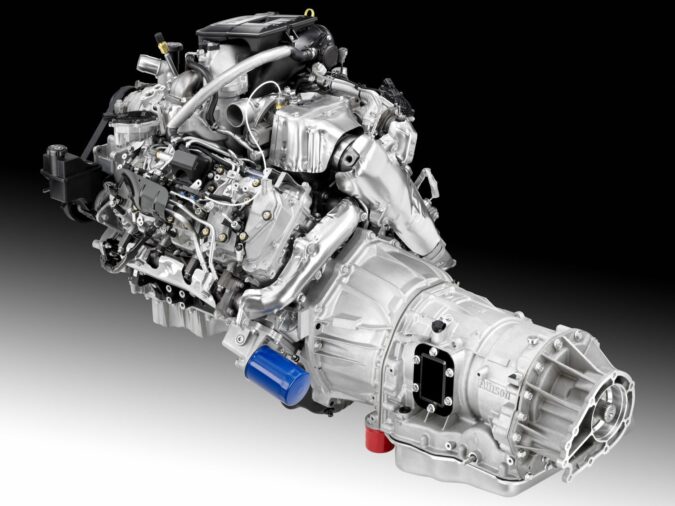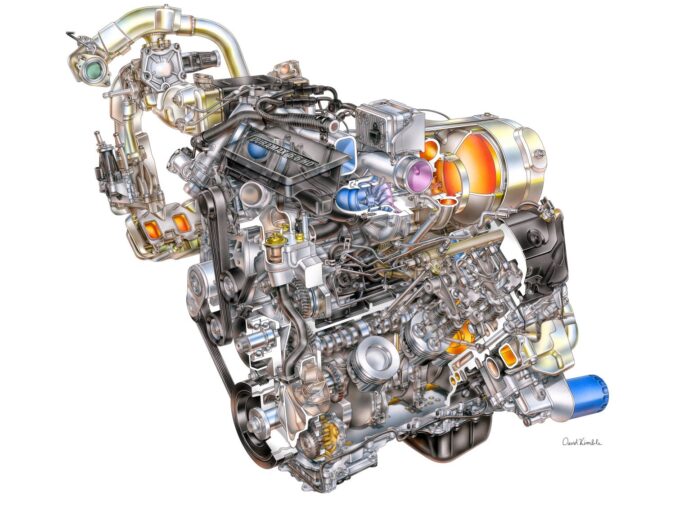General Motors is one of the largest pickup trucks in the world, with popular brands like Chevrolet and GMC under its corporate umbrella. Aside from making trucks, they also make pretty solid powertrains, too. The Duramax 6.6 diesel, for example, remains a top choice for its sheer power and torque. However, what does the MPG look like with a 6.6 Duramax diesel engine?
Conceived as early as 1997, this powertrain was a jointly developed engine between GM and Isuzu. On paper, it’s a 6.6-liter, turbocharged, V8 diesel engine, made specifically for heavy-duty trucks and vehicles. Later known as “Duramax”, these engines became the first high-pressure, common rail, direct-injection diesel engines of its kind to be sold in the US.
DMax Ltd, a 60-40 joint venture company between GM and Isuzu, was even founded to build these Duramax engines. Since the first Duramax engines rolled off the line in 2000, more than 2 million engines have been made. All of them came out of DMax Ltd.’s plan in Moraine, Ohio. This 6.6-liter aluminum head turbo-diesel V8 was just one of many Duramax engines.
How Much Is The Average Duramax 6.6 Turbo Diesel V8 MPG?
GM’s and Isuzu’s 6.6 Duramax turbo diesel V8 was far ahead of its time when it came out, but alas, MPG wasn’t a top priority. Still, an average of 13 to 15 MPG is pretty respectable and is on par with GM’s, Chevy’s, and GMC’s rivals from Ford or Cummins. When you combine that with an abundance of performance and dependability, you can see why it’s so popular.
Some owners of these Duramax 6.6 turbo diesel engines have even hit near 20 MPG. If these figures for the 6.6 Duramax diesel MPG are rather low for you, there are other options. One such choice is tuning your Duramax turbo-diesel V8. Some folks have recommended removing or bypassing the emissions systems to make your engine breathe a bit easier.
Doing so entails removing the EGR valve and deleting the DPF. That said, you should know that this could be illegal in some states. Moreover, bypassing these systems may affect your vehicle’s warranty, resale value, and servicing, and potentially cause unwanted damage or wear elsewhere. But, you may be able to boost the MPG by up to about 18 to 22 MPG.
With that in mind, the better, safer, and more environmentally friendly alternatives that I’d recommend are springing up for the smaller Duramax engines. Those inline-4 and V6 Duramax motors could supposedly get up to 33MPG. The downside is that they do lack the towing capacity. All in all, as far as MPG goes, the Duramax 6.6 diesel is decent.
Breaking Down The Duramax 6.6 Turbo Diesel V8 MPG
To get a better understanding of how much the average 6.6 Duramax turbo diesel V8 MPG is like in the real world, we’re using data from Fuelly.com. They compile data from hundreds or thousands of real-world owners who regularly experience these fuel economies. 6.6 Duramax turbo-diesel V8s included. Of course, the real MPG figures might vary for you.
Your mileage may vary, as the fuel economy figures differ depending on a few key factors. These could be, for example, how fast you’re driving, how aggressive or smooth your driving style is, as well as how much cargo are you hauling or the load that you’re towing. Still, data from Fuelly.com reflects millions, or tens of millions, of driven miles.
So, it should give us a pretty good idea of how the MPG of a 6.6 Duramax diesel V8 varies. Plus, these are their actual results over daily workloads typical of any would-be owner of a pickup that had a large-capacity V8. And, we’ll look at the most common vehicles fitted with the 6.6-liter Duramax turbo-diesel V8; the Silverado and Sierra. This includes the…
- Silverado 2500HD
- Silverado 3500HD
- Sierra 2500HD
- Sierra 3500HD
So, here’s what the average MPG for a 6.6 Duramax turbo diesel V8 MPG looks like, according to data from Fuelly.com:
1. Chevy Silverado 2500HD
| Chevrolet Silverado 2500HD | ||||
|---|---|---|---|---|
| Engine: 6.6-Liter Duramax Turbo-Diesel V8 | ||||
| Sample Size: 1,383 Vehicles | ||||
| Total Miles Driven: 35.4-Million | ||||
| Model Year | Average MPG | Samples | Total Fill-Ups | Miles Tracked |
| 2001 | 15.5 | 31 | 2,535 | 835,319 |
| 2002 | 15.0 | 79 | 6,417 | 1,899,631 |
| 2003 | 14.7 | 94 | 5,233 | 1,625,793 |
| 2004 | 14.4 | 90 | 5,943 | 1,812,212 |
| 2005 | 14.1 | 145 | 13,417 | 3,388,493 |
| 2006 | 14.4 | 127 | 11,572 | 3,129,369 |
| 2007 | 14.6 | 151 | 17,212 | 4,600,413 |
| 2008 | 14.3 | 76 | 8,167 | 1,956,412 |
| 2009 | 13.1 | 42 | 4,343 | 1,012,271 |
| 2010 | 14.8 | 8 | 975 | 286,100 |
| 2011 | 13.7 | 57 | 4,284 | 1,418,418 |
| 2012 | 13.4 | 34 | 2,865 | 1,048,639 |
| 2013 | 15.0 | 40 | 4,137 | 1,463,266 |
| 2014 | 13.9 | 22 | 1,652 | 587,349 |
| 2015 | 13.8 | 125 | 9,982 | 4,132,788 |
| 2016 | 14.4 | 76 | 7,254 | 2,605,055 |
| 2017 | 14.0 | 48 | 2,999 | 1,112,380 |
| 2018 | 13.5 | 41 | 2,594 | 934,020 |
| 2019 | 14.5 | 48 | 2,537 | 889,454 |
| 2020 | 14.1 | 28 | 957 | 471,309 |
| 2021 | 14.8 | 21 | 452 | 165,242 |
2. GMC Sierra 2500HD
| GMC Sierra 2500HD | ||||
|---|---|---|---|---|
| Engine: 6.6-Liter Duramax Turbo-Diesel V8 | ||||
| Sample Size: 745 Vehicles | ||||
| Total Miles Driven: 18.7-Million | ||||
| Model Year | Average MPG | Samples | Total Fill-Ups | Miles Tracked |
| 2001 | 14.2 | 17 | 564 | 176,251 |
| 2002 | 13.5 | 18 | 1,725 | 654,343 |
| 2003 | 15.2 | 43 | 2,906 | 939,067 |
| 2004 | 15.3 | 37 | 4,177 | 1,163,787 |
| 2005 | 13.7 | 38 | 3,238 | 822,195 |
| 2006 | 14.7 | 72 | 9,295 | 2,304,380 |
| 2007 | 14.7 | 48 | 4,574 | 1,154,296 |
| 2008 | 14.4 | 51 | 8,041 | 2,076,806 |
| 2009 | 14.4 | 16 | 829 | 289,123 |
| 2010 | 14.9 | 9 | 552 | 169,565 |
| 2011 | 14.1 | 33 | 2,068 | 722,273 |
| 2012 | 13.6 | 25 | 2,499 | 846,701 |
| 2013 | 13.2 | 35 | 1,913 | 659,135 |
| 2014 | 13.4 | 18 | 1,266 | 425,129 |
| 2015 | 13.6 | 75 | 5,349 | 1,844,103 |
| 2016 | 13.9 | 55 | 4,167 | 1,505,185 |
| 2017 | 14.1 | 40 | 2,827 | 1,008,952 |
| 2018 | 15.3 | 47 | 2,907 | 1,194,418 |
| 2019 | 14.4 | 18 | 735 | 299,630 |
| 2020 | 14.9 | 22 | 748 | 292,134 |
| 2021 | 13.5 | 28 | 555 | 191,410 |
3. Chevrolet Silverado 3500HD
| Chevrolet Silverado 3500HD | ||||
|---|---|---|---|---|
| Engine: 6.6-Liter Duramax Turbo-Diesel V8 | ||||
| Sample Size: 287 Vehicles | ||||
| Total Miles Driven: 6.2-Million | ||||
| Model Year | Average MPG | Samples | Total Fill-Ups | Miles Tracked |
| 2007 | 12.0 | 10 | 940 | 339,170 |
| 2008 | 12.0 | 22 | 1,438 | 423,705 |
| 2009 | 11.6 | 9 | 431 | 124,587 |
| 2010 | 13.2 | 5 | 257 | 96,649 |
| 2011 | 12.8 | 18 | 1,741 | 511,510 |
| 2012 | 12.1 | 9 | 788 | 253,996 |
| 2013 | 12.4 | 17 | 984 | 356,883 |
| 2014 | 13.4 | 7 | 549 | 197,496 |
| 2015 | 12.5 | 45 | 2,974 | 1,057,307 |
| 2016 | 13.0 | 29 | 2,417 | 803,584 |
| 2017 | 12.9 | 20 | 1,474 | 477,560 |
| 2018 | 12.4 | 23 | 2,102 | 627,045 |
| 2019 | 13.7 | 24 | 1,323 | 475,951 |
| 2020 | 14.1 | 24 | 764 | 306,541 |
| 2021 | 12.6 | 25 | 471 | 140,206 |
4. GMC Sierra 3500HD
| GMC Sierra 3500HD | ||||
|---|---|---|---|---|
| Engine: 6.6-Liter Duramax Turbo-Diesel V8 | ||||
| Sample Size: 227 Vehicles | ||||
| Total Miles Driven: 5.3-Million | ||||
| Model Year | Average MPG | Samples | Total Fill-Ups | Miles Tracked |
| 2007 | 12.8 | 7 | 267 | 83,916 |
| 2008 | 13.4 | 6 | 672 | 195,718 |
| 2009 | 15.2 | 5 | 161 | 68,057 |
| 2010 | 13.0 | 4 | 230 | 74,185 |
| 2011 | 13.3 | 13 | 870 | 314,047 |
| 2012 | 13.3 | 13 | 1,632 | 570,135 |
| 2013 | 12.2 | 12 | 1,510 | 443,648 |
| 2014 | 12.1 | 5 | 422 | 162,266 |
| 2015 | 14.2 | 30 | 2,455 | 933,651 |
| 2016 | 13.1 | 22 | 1,706 | 531,886 |
| 2017 | 13.2 | 20 | 1,757 | 587,777 |
| 2018 | 11.7 | 21 | 1,394 | 459,578 |
| 2019 | 10.9 | 17 | 1,234 | 358,447 |
| 2020 | 13.5 | 27 | 826 | 308,366 |
| 2021 | 13.7 | 25 | 519 | 172,363 |
Evolution Of The Duramax 6.6 Turbo Diesel V8 Engine
And hey, while we’re, and given the long lifespan of the Duramax 6.6 turbo diesel V8, here’s a rundown of how it’s evolved, since its initial introduction in 2001…
1. LB7 (2001 To Early-2004 Model Year)
The 6.6 Duramax diesel V8 ‘LB7’ was the first. From 2001, the LB7 was manufactured until early 2004. It has a 32-valve design, with a ground-breaking high-pressure common-rail and direct injection design. Plus, the LB7 included a then-experimental composite cylinder head. It was used in the Chevrolet Silverado HD and GMC Sierra HD, between 2001 to 2004.
Nevertheless, the LB7 was uprated and was capable of powering larger medium-duty trucks, too. This included the Chevrolet Kodiak and the GMG TopKick. Other than that, here’s a brief list of its many features:
- It had a cast-iron engine block, with aluminum heads, and was naturally aspirated.
- That direct-injection high-pressure common-rail system was conceived by Bosch.
- At its peak in 2004, horsepower was rated at 300hp, with another 520lb-ft of torque. The earlier 2001 to 2003-spec engines had 235hp and 500lb-ft of torque.
- The compression ratio was a fairly high 17.5:1.
- LB7s were commonly mated to a commercial-grade 5-speed Allison automatic gearbox. There was also a 5-speed manual.
- They were incredibly reliable owing to their simplistic and robust design.
- Unfortunately, LB7s were infamous for fuel injector failure, which prompted a recall. Not only did GM replace the injectors, but also tossed in an extended 200,000-mile warranty for those injectors. The fault was mainly blamed on poorly filtered diesel.
- As the LB7 was unveiled before stringent emissions regulations, it didn’t include any diesel exhaust fluid (DEF), diesel particulate filter (DPF), or selective catalytic reduction (SCR) systems.
2. LLY (Mid-2004 To 2006 Model Year)
After the smash hit that was the LB7, changes were made to the 6.6 Duramax diesel V8. This came out as the ‘LLY’, which replaced the LB7 mid-year through 2004. The LLY was mostly the same, as it was fitted on the following iterations of the Chevy Silverado HD and GMC Sierra HD. Nonetheless, GM has become more conscious of its emissions output by now.
While the LB7 was naturally aspirated, the LLY had a Garrett turbocharger – which remains to this day. It was tuned to include a variable geometry vane system, and GM-Isuzu installed an EGR valve, too. Outside of Chevrolet and GMC, Hummer included the 6.6 Duramax turbo diesel in the H1 Alpha. Apart from that, here are some unique features of the LLY:
- Power output was raised across the board to 310hp and 520lb-ft of torque. However, in the 2006 model year, torque was increased further to 605hp.
- Owing to that Garrett turbocharger and the inclusion of variable valve timing tech, torque could be delivered at revs as low as 1,600RPM.
- The LLY had emissions-controlling systems, whereas the LB7 did not.
- It wasn’t just less polluting than the outgoing LB7, but delivered greater performance and made the engine easier to drive.
- The fuel injector failures from the LB7 were solved with the LLY. Plus, the valve covers were changed so that access to the injectors was much easier.
- LLYs became especially heaty while towing, and GM has blamed the issue on restrictive cooling or airflow.
3. LBZ (Mid-2006 To 2007 Model Year)
Production on the LLY’s successor, the LBZ (not the “LB7”) 6.6 Duramax turbodiesel V8 commenced in mid-2006. From then on to the 2007 model year, it was once again fitted to the Chevy Silverado HD and GMC Sierra HD. The most noticeable improvement was in its performance. Now, the LBZ could deliver a respectable 360hp as well as 650lb-ft of torque.
Additionally, upgraded versions of the LBZ were included in the Chevy Kodiak and GMC TopKick. The Chevrolet Express and GMC Savanna vans also had this same 6.6 Duramax as an option on higher-end trims. However, the latter two had a reduced power output and were fitted to a 4L85E automatic gearbox. The LBZ had a huge host of enhancements, including:
- Being pre-emissions, it had no DPFs.
- The cylinder block machining and bearing material were strengthened.
- The compression ratio was lowered to 16.8:1, which included revised cylinder heads.
- The piston pin bore diameter and connecting rod sections were enlarged for better durability.
- The injection pressure was upped from 23,000psi to more than 26,000psi.
- There were new seven-hole fuel injectors, a higher-pressure fuel pump, and new fuel rails.
- An upgraded set of glow plugs ensures more reliable cold starts.
- The Garrett turbocharger is more efficient, delivers power more smoothly, and cuts down on emissions.
- EGR valves had a larger cooler and intake to bring higher volumes of exhaust fumes to the engine.
- The LBZ had a new 32-bit E35 controller that could compensate for fuel flow much quicker.
4. LMM (2007 To Early-2010 Model Year)
The ‘LMM’ update to the 6.6 Duramax diesel line-up was featured predominantly in the Chevy Silverado and GMC Sierra. Furthermore, it can be found in the Kodiak, TopKick, Express, and Savanna. The highlight of the LMM was no doubt GM-Isuzu’s ability to crank out more performance, despite ever restrictive and stringent emissions regulations.
The LMM could output 365hp and 660lb-ft of torque, which was fairly impressive for its class. As with the LBZ, LMMs were mated to an Allison 1000 6-speed auto or a ZF S6-650 6-speed manual. Assembled in April 2007, a particular LMM motor also marked the one-millionth Duramax diesel V8 built. Here are some of the changes in the LMM:
- As it had a diesel particular filter (DPF) and exhaust gas recirculation (EGR) system, the LMM could get pretty hot. To help with cooling, LMM engines had a larger EGR cooler.
- The LMM featured closed crankcase ventilation to reduce nitrogen oxide (NOx) emissions.
- Its variable-geometry turbocharger was fine-tuned to be more efficient and potent.
- It had a redesigned fuel injector, which now features a 6-hole nozzle design and a 159-degree spray.
- LMMs – as with the earlier LBZ motors – have pistons that can be prone to cracking under heavy load.
- For improved performance, the LMM had better cooling, a new ECU, and other little tweaks (like a revised head design) over the LBZ.
5. LGH (2010 To 2011 Model Year)
Another key generational upgrade to the 6.6 Duramax turbo-diesel V8 began in 2011 with the ‘LGH’. The LGH is included as a standard fit on several heavy-duty trucks and vans. Although, the vans – Chevy Express or GMC Savana – had a lower power output of 260hp and 525lb-ft of torque. Meanwhile, the trucks could make do with 335hp and 685lb-ft of torque.
This time, you only get one transmission option, a 6-speed ‘MYD-6L90’ automatic. Changes aplenty include a higher injection pressure, now sustaining upwards of 2,000 bar. Thanks to its emissions kit, the LGH can reduce harmful NOx emissions by at least 63%. Aside from being a very clean diesel engine, the LGH Duramax is compatible with B20 biodiesels.
- The casting and machining on the cast-iron cylinder block have been strengthened. The crankcase, meanwhile, is now made out of aluminum to reduce weight.
- Pistons have been redesigned without pin bushings to reduce reciprocating weight. This allows the engine to rev quicker and become more responsive.
- There are piston-cooling oil jets that help to lubricate and cool the pistons, preventing excess wear.
6. LML (2011 To 2016 Model Year)
Whereas the LGH 6.6 Duramax diesel was meant to be an interim engine, then came the LML for the 2011 to 2016 model years. Mechanically, the LML was mostly similar to the LGH. As such, it had a better piston oil flow design that improved temperature control and a new oil pump design. This adds to its ease of use, with better power and emissions.
Power was rated at 397hp and 765lb-ft of torque. It was compatible with the LGH’s 29,000psi Piezo injectors. Plus, it’s compatible with B20 biodiesel mixes, with improved recycling of exhaust fumes and unburnt fuel. Alongside the DPF regeneration, enhanced turbocharger, and other tweaks to the engine, the LML is both powerful and cleaner than ever.
- The crankshaft and connecting rods are made from forged steel, hardening them against wear and tear.
- Engine lubrication systems have been redesigned to keep the motor slicker and operate more quietly than before.
- Aluminum cylinder heads can take on the high engine compression, and aid to cut down on weight.
7. L5P (2017 Model Year To Present)
Finally, we get to the L5P, which is the current generation of the 6.6-liter Duramax turbo-diesel V8s. This could very well be the prime of the 6.6 Duramax, with a power output of 445hp and a massive torque figure of 910lb-ft. This is pretty impressive and mated to an equally capable Allison MW7-LCT 1000 gearbox. There’s also an L5D variant for medium-duty trucks.
These include the Silverado 4500HD, 5500HD, and 6500HD. The L5P marks another leap forward for Duramax V8s over the LGH. For instance, there’s a stronger cylinder block and rotating assembly, as well as a new and reprogrammed ECU. 90% of its peak torque could be accessible from just 1,550 RPM. Some of the other features and notable changes are:
- Completely new camshaft design, and a re-engineered cylinder head.
- Electronically-controlled variable-vane turbocharger – more horsepower, with lower emissions.
- A heavily revised air intake system with a hood scoop. This should aid in cooling and providing more sustained performance, especially while towing or hauling heavy loads.





I am trying to find out roughly what kind of fuel mileage a 2006 2wheel drive Top kick c4500 gets. Empty most of the time
Tommy, when it comes to determining the fuel mileage of a 2006 2-wheel drive Topkick C4500, there are several factors to consider. While I don’t have specific data for that exact model, I can provide you with some general information. The fuel mileage of any vehicle can vary based on driving conditions, maintenance, and driving habits.
Typically, larger commercial vehicles like the Topkick C4500 tend to have lower fuel efficiency due to their size and weight. However, since you mentioned that it would be empty most of the time, it might have a slightly better fuel mileage compared to when it’s fully loaded.
To get a more accurate estimate of the fuel mileage for your specific vehicle, it would be helpful to check the owner’s manual or reach out to the manufacturer or previous owners who may have firsthand experience with this particular model. Additionally, online forums or communities dedicated to truck enthusiasts might provide valuable insights from owners who have similar setups.
Remember that individual driving habits and conditions play a significant role in fuel consumption. Factors such as speed, acceleration, terrain, and even weather conditions can all influence fuel efficiency. Therefore, it’s always advisable to drive sensibly and keep up with regular maintenance to ensure optimal fuel mileage.